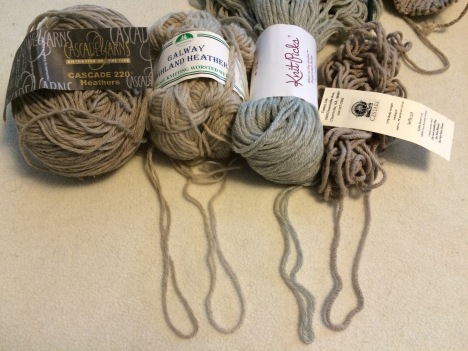There seems to be a great variation between what different yarn companies classify as “Worsted” or “Bulky” these days.
The Cascade 220 seems a little skimpy compared to other worsteds in my stash, such as Plymouth Galway. Now, the Wool of the Andes Bulky (WOTA) seems to be just barely thicker than the Cascade 220. While the Cestari seems gigantic (super bulky), the WOTA doesn’t seem bulky at all — more like worsted or heavy worsted.

Cascade 220, Galway, WOTA Bulky, Cestari Bulky.
I want this sweater to be somewhat sturdy. That was why I rejected the Cascade 220, which had a lovely soft, pliant feel which might be perfect for an indoor sweater, but didn’t seem thick or tough enough for outerwear.
Now, I’m going with the WOTA Bulky, but it doesn’t feel bulky or tough enough, either.
In the picture, the Cestari doesn’t look much bigger than the WOTA. The difference is in the density. There’s a lot of wool in the Cestari, while there’s a lot of air in the WOTA. The Cestari is as thick & dense as a tree trunk, while the WOTA is just feathers.
A few years ago, I acquired a healthy-sized stash when three yarn stores in my area closed, so I haven’t been buying yarn. Nothing in my stash suits this project, though, so I’m forced to buy yarn. I’ve discovered that several of my favorite online sources are gone, and my lys* doesn’t carry some of the yarns they used to. So, my choices have narrowed considerably, and I seem to be limited to the three already mentioned.
* lys = local yarn shop

Cascade 220, WOTA & Cestari
The difference can be seen more plainly in this picture. The thick-looking strands of the WOTA were compressed a lot by the braid pattern, while the dense strands of the Cestari couldn’t be compressed by anything less than a steamroller. When I make a sweater with Cestari, it will be as dense and protective as any coat I own. But I want the sweater I’m currently making to be a little less dense, while retaining some strength.
Several years ago, I made Meg Swansen’s Shawl-Collared Vest.** Cash was tight, so I made it with Lion Brand Fishermen’s Wool, which looked as nice as a lot of more-expensive natural wools. But, like the WOTA, it seems to have a lot of air in it. It looks ok, but it’s flimsy, and not nearly as warm as it could be. I never wear it.
I am concerned that I’ve now made another bad decision, and will put a lot of work into a sweater which won’t be worth the effort.
–
** Swansen, Meg, Handknitting with Meg Swansen, Schoolhouse Press, 1997-ish
I can’t lay hands on the book right now (for the same reason I didn’t have access to Myrna Stahman’s shawl book in 2014 (1st Project: The Rail Yard Shawl) ), and can’t find the publishing info on their website. Will update this when I can.
–
Test Swatch Trio
Re: Photo of the three test swatches: At the time I took the photo, I’d misplaced the label, but the one on the left is the Cascade 220. I could PhotoShop the label in, but I cannot re-take the picture, since after I took it, I ripped out the WOTA swatch so I could start my sweater with it. The other two swatches still exist, in case I need them later.

Feline help
Buttercup thought the swatches looked lonely. Notice how artfully she obscures the Cestari label.
\










